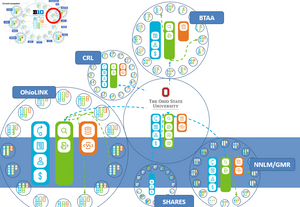This is the second of 4 blog posts about library consortia. I will link to the others here as they appear:
- The powers of library consortia 1: How consortia scale capacity, learning, innovation and influence
- The powers of library consortia 2: Soft power and purposeful mobilization: scaling learning and innovation
- The powers of library consortia 3: Scaling influence and capacity
- The powers of library consortia 4: Scoping, sourcing and scaling
While one might first think of scaling capacity (e.g. shared infrastructure) or scaling influence (e.g. lobbying government on public policy issues affecting scholarly communication) in connection with library consortia, learning and innovation are increasingly central.

Learning and innovation
Learning and innovation have become crucial for successful library activity. As the practices and expectations of library users – as creators and users of information in their research, learning and general lives – continue to change and as the information environment continues to diversify, it becomes increasingly important for libraries to be able to respond quickly. To do this effectively, the library needs to understand directions and develop responsive services. And this in turn depends on effectively scaling learning and innovation within and across libraries.
Scaling learning
Professional development or continuing education is an important part of many groups’ activities. The group may provide some economies of provision or shared expertise, and for this reason could have been included in the later scaling capacity section.
However, I am thinking here of learning in a broader sense. John Hagel talks about the importance of learning and the exchange of tacit knowledge in environments of uncertainty like ours:
In rapidly changing environments, it’s important to realize that tacit knowledge trumps explicit knowledge. The latter can be articulated and written down and it usually takes time before it can be expressed clearly and coherently to others. Tacit knowledge is within our heads and we have a hard time even expressing it to ourselves, much less to anyone else. Because tacit knowledge is generally newer knowledge, emerging from new experiences that we’ve encountered, it’s often the most valuable knowledge, providing us with insight into how to act in a rapidly evolving environment.
Tacit knowledge becomes accessible through shared practice
Because it’s so hard to express, tacit knowledge is not easily accessible. The best way to access it is to work together and to observe the practices that emerge from this tacit knowledge. By working together, we also develop deeper, trust-based relationships that create a safer environment for us to explore new insights with others in our group that we have a hard time expressing to ourselves. [Scaling Learning in an Exponential World. Edge Perspectives by John Hagel.]
The importance of learning through shared practices highlights the importance of people networks. Those networks in turn foster trust and ongoing serendipitous interactions. While there may be some concern about groupthink, trust also encourages an environment of frank discussion and challenge.
This provides the context for my thinking about two related aspects of library groups.
First, there are those groups which have an explicit and central role in facilitating professional networks, communities of practice, leadership development and peer learning. This may be the primary focus of some groups. Think, for example, in their different ways, of CNI, the OCLC Research Library Partnership (RLP), DLF, or the DPC (in the UK). Or it may be one element of a group’s activity. LIBER, for example, notes on its website: “Moreover, we contribute towards the development of innovative library leaders through our many conferences, workshops and seminars.” Think of the ALA divisions, LLAMA, ACRL or LITA, for example, where professional development is a driver of participation. One of the stated purposes of ARL is “fostering the exchange of ideas and expertise.” And it now has an explicitly programmatic approach to scaling learning through the ARL Academy, which aims to give attention to communities of practice, leadership development and workforce transformation. RLUK’s initiatives around unique and distinctive collections is a further example of a programmatic approach. JULAC, the consortium of university libraries in Hong Kong, also has a programmatic approach to creating learning opportunities across the libraries.
This learning role is also an important and explicit part of more functionally specific groups, Duraspace, the Digital Preservation Coalition or the Library Publishing Coalition, for example, or the Data Curation Network, which was explicitly created to scale expertise across the members. The Library Publishing Coalition notes that it “fosters collaboration, knowledge-sharing, and the development of common practices for library publishers.”
The second way in which scaling learning is important for groups relates to what I have called the ‘soft power’ of groups. I spoke to a library director a couple of years ago who was trying to join a larger regional consortium. Scaling capacity was certainly an important driver, around digital infrastructure, shared systems and negotiation. However, scaling learning was an equally strong incentive. She wanted her colleagues to mix with their peers in a broader group, to have a community within which to understand shared print, research data management, the different strands of open access, and other emerging service areas. Having such a peer group also gave access to “evidence and arguments” which could be used in discussions with administration and faculty in her own institution. The group would make her library smarter in terms of direction and local advocacy. In this way, the group scales learning across the members, and engagement in shared practices potentially accelerates local developments. Groups allow library staff to network with each other, to discuss direction, to come to shared decisions, to ‘pool uncertainty’ (and to reduce uncertainty as shared perspectives shed light on problems), and to build confidence in judgements. Staff can work with peers from other institutions, or mix with people with different experience and perspectives. Managing committees and working groups provides leadership and other development opportunities. In this way, a group may be an important factor in individual advancement or succession planning as participation becomes a platform for personal development as opportunities arise within the consortium.
Librarians come together around shared practices. The value of this soft power should not be underestimated. This is a central reason for the persistence of many groups.
Scaling innovation
When we think of innovation, we tend to think of novel or interesting new approaches. These may arise in multiple contexts: in libraries, from vendors, and so on.
However, for an innovation to have impact beyond its original context it must be adopted by a wider group. At the same time, an institution will want to adopt appropriate innovation from elsewhere. Much innovation needs to become systemic to have an impact or to become economical. Innovation is especially important, again, in an environment where research and learning behaviors are changing and in turn changing the demands placed on libraries. Innovations may be around workflow, use of spaces, services, technology, and so on.
The University Innovation Alliance is an interesting experiment in relation to what I mean by scaling innovation. A group of public research universities dedicated to increasing access and student success, they are looking at techniques for diffusing the innovation of individual institutions across the group to see what works on a larger scale. The goal is to leverage individual institutional successes, while reducing redundant experimentation within the group. It is an example of a consortium explicitly focused on scaling innovation: they will “innovate, scale and diffuse.” Their first focus is learning analytics, looking at how developments at pioneer institutions might be adapted by others.
The UIA has a three-stage scaling model:
- Identifying new solutions.
- Scaling proven innovations.
- Communication and diffusion.
We have yet to see what impact the UIA has, but the motivation and the approach are intriguing.
Scaling innovation is an important part of library groups, although there is not a library group with the very specific focus of the UIA. The Urban Libraries Council, for example, holds an annual competition to demonstrate innovation in several categories. A part of the purpose is to promote innovation by example across the membership. The Lyrasis Catalyst Fund provides another example, which supports projects with potential community wide impact. SCELC has a competitive Project Initiatives Fund to advance its strategic initiatives.
Creating a network is central to each of the examples above – a network in which new approaches can be socialized and embedded. This is an important aspect of library (and related) consortial activity. This may be in specialist groups like the Open Text Network or Data Curation Network. Or it may be more general – Educopia or Duraspace, for example, have a mission to develop networks which support diffusion and adoption of innovations. Likewise, CNI, the OCLC Research Library Partnership or DLF have an important goal to help socialize and embed innovation. This is certainly also the case with broader groups: Jisc in the UK comes to mind which has a very specific goal of helping to identify, incubate and diffuse innovation.
Again, the soft power of consortia is important here: ‘network making’ helps diffuse innovation, moving it into practice. However, there is also scope for more purposeful work to scale innovation across institutions, which is what makes the example of the UIA interesting.
Conclusion
Scaling learning and innovation is actually a central part of library groups and consortia. Often this is a by-product of the “soft power” of such groups, bringing people together around shared practices and problems, mobilizing the trust networks they have created. In this way learning and innovation are emergent – building on the sharing of knowledge and experience in ongoing organizational relationships. From the point of view of consortium staff this is a critically important and valuable benefit, even if it is not always called out explicitly as a service. It would make sense to make it more explicit.
We are also seeing more purposeful approaches, which recognize the importance of learning and innovation – and their intimate connection – in an environment of uncertainty and change. As libraries work to be more active partners and advocates for their communities, they recognize the need to be more responsive and adaptive. This makes it vital to have good mechanisms for scaling learning and innovation within and across libraries, and through the collaboration networks which consortia create.
Acknowledgements. I am grateful to the following people for generous comments on earlier drafts: Gwen Evans, Mike Furlough, Kevin Guthrie, Susan Haigh, Brian Lavoie, Kirsten Leonard, Rick Lugg, John MacColl, Constance Malpas, Barbara Preece, Judy Ruttenberg, Katherine Skinner, John Wilkin, Nicola Wright. Of course, I alone am responsible for the use to which I have put their advice and they do not necessarily share any of the views expressed here! I presented some of this material at the JULAC 50th Anniversary Conference in Hong Kong, and I benefited from the views outlined in the formal responses of Peter Sidorko and Louise Jones.
Picture: I took the feature picture of the Thompson Library at Ohio State University. OSU is a member of OhioLINK, a pioneering library consortium.
Note: I made some cosmetic updates including adding picture and headings on 20 March 2021.




